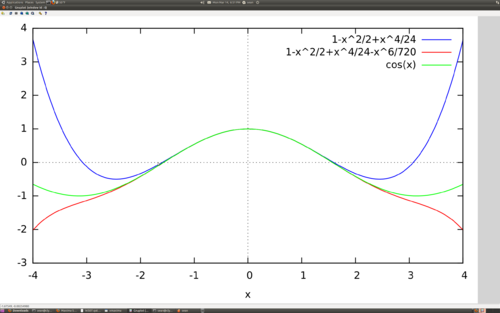Difference between revisions of "Taylor Series"
From Sean_Carver
(→New Concept: Taylor Series) |
(→New Concept: Taylor Series) |
||
| Line 31: | Line 31: | ||
* Example: The Taylor series for cos(x), at a = 0. Partial sums for 4 and 6 terms. | * Example: The Taylor series for cos(x), at a = 0. Partial sums for 4 and 6 terms. | ||
[[Image:taylorcos46.png|500px|thumb|center|cos(x) and Taylor series partial sums for cos(x), 4 and 6 terms ]] | [[Image:taylorcos46.png|500px|thumb|center|cos(x) and Taylor series partial sums for cos(x), 4 and 6 terms ]] | ||
| + | |||
| + | == Try it yourself == | ||
| + | |||
| + | Open Maxima and type (or copy and paste): | ||
| + | |||
| + | a:0 | ||
| + | n1:4 | ||
| + | n2:6 | ||
| + | M:4 | ||
| + | plot2d([taylor(cos(x),x,a,n1), taylor(cos(x),x,a,n2), cos(x)],[x,-M,M]) | ||
Revision as of 23:14, 14 March 2011
Review Concepts
- Sequences
- Convergence
- Infinite series
- The sequence of partial sums of an infinite series
- Power series
New Concept: Taylor Series
- Think of Taylor series as a special kind of power series, where the sequence of partial sums are meant as better and better approximations of some other function.
- The Taylor Series is derived from the function.
Definition copied, verified, and adapted from Wikipedia, this page (permanent link). See license to copy, modify, distribute.
The Taylor series of a function ƒ(x) at a is the power series
which can be written in the more compact sigma notation as
- Convergence: A function whose Taylor series converges to the function is called analytic. But sometimes, as we have seen with power series generally, convergence can occur only within a radius of convergence.
- Example: The Taylor series for cos(x), at a = 0. Partial sums for 4 and 6 terms.
Try it yourself
Open Maxima and type (or copy and paste):
a:0 n1:4 n2:6 M:4 plot2d([taylor(cos(x),x,a,n1), taylor(cos(x),x,a,n2), cos(x)],[x,-M,M])


